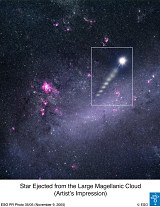Massive Black Hole
By: David Bradley
 A
massive, or rather supermassive, black hole, millions of times the
mass of the sun, has been spotted by UK and German astronomers.
A
massive, or rather supermassive, black hole, millions of times the
mass of the sun, has been spotted by UK and German astronomers.
The team from the Centre for Astrophysics Research at the University of
Hertfordshire and Remeis-Sternwarte at the University of
Erlangen-Nuernberg discovered a short-lived massive star, crisply named HE
0437-5439, which is moving at such a high speed through the outer halo of the
Milky Way and into intergalactic space, that it could only have been sent on
its way by something of enormous bulk - a massive black hole!
The finding has come as a big surprise to the astronomers as massive stars
have lifetimes of only some tens or hundreds of million years and the halo
does not usually host stars as young as HE 0437-5439, which the team has
estimated is 30 million years old. The position of the star in the sky has
raised many questions as to how it came to be in its present location. Stars
can be ejected by supermassive
black holes as the one known in the centre of our Milky Way. However, a
Milky Way origin for 0437-5439 is unlikely.
This has led the astronomers to suspect that the star could have travelled its current distance if it were ejected from the centre of the Large Magellanic Cloud (LMC), from where at the time of the observation it was 16 degrees away. The astronomers look forward to having these and other questions answered by forthcoming astrometric space missions such as GAIA which is due to be launched in 2011. Work on this project was supported by the Particle Physics Astronomy Council (PPARC) and the Deutsche Forschungsgemeinschaft (DFG).
Related Information